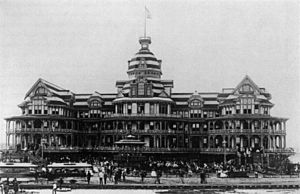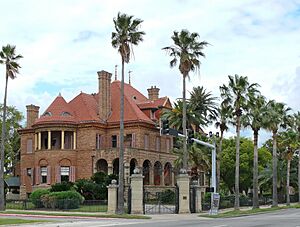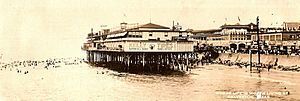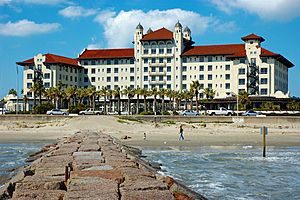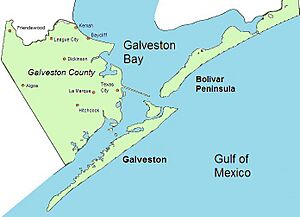Free State of Galveston facts for kids
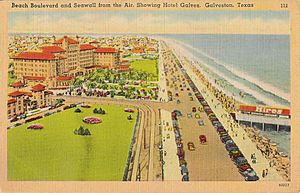
Postcard view of Beach Boulevard and the Hotel Galvez, early 1940s
|
|
| Date | 1920–1957 |
|---|---|
| Location | Galveston, Texas, United States |
| Also known as | Republic of Galveston Island / Open Era of Galveston |
The Free State of Galveston was a fun nickname for the city of Galveston, Texas in the United States during the early to mid-1900s. People sometimes use this name today to talk about the special culture and history of that time.
During the 1920s, Galveston Island became a very popular resort town. Many famous people visited from all over the country. The city offered lots of entertainment, including games of chance and places to get drinks, even though some of these activities were not allowed by law.
The name "Free State" showed how many locals felt. They believed Galveston was different from other places in Texas and the U.S. They thought it had its own rules and a more relaxed way of life.
Two important people from this time were brothers Sam and Rosario Maceo. They were successful businessmen who ran the main clubs and entertainment spots on the island. They also had a lot of influence in local government and the tourism industry.
Even though some of their businesses were against the law, they succeeded because people and the government in Galveston were very understanding. For example, when a state group looked into games of chance at the famous Balinese Room, the local sheriff said he hadn't stopped them because it was a "private club" and he wasn't a "member."
This time was a high point for Galveston's economy. It's sometimes called the "open era" because businesses didn't try to hide their activities. The tourism that came from these entertainment spots helped Galveston recover after a terrible hurricane in 1900.
However, laws against games of chance in Texas became stricter in the mid-1900s. This made it harder for these businesses to continue. By the late 1950s, this special time in Galveston's history had ended. After that, the city's economy struggled for many years.
Contents
Galveston's Early History and Challenges
Galveston Island is located on the Gulf of Mexico. It was one of the first big settlements in what is now Texas. In the mid-to-late 1800s, it grew to be the largest city in the state.
Galveston was also a very important business center for the country. Its port was one of the busiest in the U.S. because it handled a lot of Texas's cotton trade. Downtown Galveston was even called the "Wall Street of the Southwest." By 1900, the city had a very high income per person.
Even though Houston was growing, Galveston was the main cultural and economic center of Texas back then. Activities like games of chance were common across Texas in the 1800s. They continued to be accepted in Galveston in the early 1900s.
The 1900 Galveston hurricane was a huge disaster. Between 6,000 and 12,000 people died, and many more were affected along the coast. Right after the storm, Galveston worked hard to rebuild its port and become an entertainment spot again. They built places like the Hotel Galvez, which opened in 1911.
In the same year, the Galveston–Houston Electric Railway opened. It was known as the fastest interurban (between cities) rail system in the country. Galveston's port was also rebuilt quickly. By 1912, it was the second-biggest exporter in the nation, after New York. Still, after the 1900 storm and another in 1915, many people avoided investing money on the island.
Galveston was a major entry point for people coming to Texas and the western U.S. in the 1800s. A new wave of immigrants arrived through the port in the early 1900s. For a while, it was called "Little Ellis Island."
These new arrivals included people from Greece, Italy, and Russian Jewish communities. Many settled across the country, and some stayed on the island. Sicilian immigrants, in particular, formed a large community in Galveston County.
The opening of the Houston Ship Channel in 1915 created more challenges for Galveston's port. Houston and Texas City, along with other ports, quickly became more important. By 1930, maps showed Houston as the main city on the Texas coast, not Galveston. Shipping cotton, which Galveston had once led worldwide, started moving to other ports.
As Galveston's traditional economy slowed down, Texas's oil boom began in 1901. Oil wells and refineries were built all over the state. Galveston didn't play a big role in this boom directly. Investors avoided building pipelines and refineries on the island.
However, the wealth from the oil boom changed nearby cities like Houston and Texas City. Houston became home to many rich business people. Galveston then focused even more on tourism to attract these new wealthy visitors. While the city had some success, its economy never reached the same level as before the 1900 storm.
The Maceo Brothers and Entertainment
In the early 1900s, many parts of the U.S. made most forms of games of chance illegal. But these activities continued secretly in many places, creating chances for organized groups. The 18th Amendment to the U.S. Constitution, passed in 1919, made it illegal to make, move, or sell alcoholic drinks. This started the Prohibition era.
This new law was not popular, and bringing in and selling illegal alcohol became very common. Galveston's already relaxed social attitudes allowed this and other entertainment businesses to grow in the city.
At the start of Prohibition, two main groups shared control of the city: the Beach Gang and the Downtown Gang. While they mostly stayed separate, fights and killings did happen. Bringing in illegal alcohol became a big business. Alcohol was brought from overseas and sold throughout the city, state, and other parts of the country.
A "rum row" of ships full of alcohol from Cuba, Jamaica, and the Bahamas often waited about 35 miles (56 km) off the coast. Smaller boats would then pick up the goods and bring them to shore.
Around this time, the Maceo family became very important to Galveston's history. Two brothers, Rosario (Rose) and Salvatore (Sam) Maceo, moved to Galveston before World War I. They started as barbers. When Prohibition began, they started giving their customers small gifts of wine they had secretly brought in. As customers wanted more, the Maceos became more serious about selling illegal alcohol. They joined forces with the Beach Gang and opened a "cold drink place," which was a secret bar. They also invested in the gang's entertainment operations.
Eventually, the Maceos, with their partners, opened the Hollywood Dinner Club. It was the most elegant nightclub on the Gulf Coast at the time. The club had beautiful chandeliers, a large dance floor, and even air conditioning, which was a new technology then. Sam Maceo was very charming, so he became the public face of the nightclub. Famous performers like Guy Lombardo played there, and Sam attracted many other celebrities. The club was unique because it offered high-class games, dining, entertainment, and air conditioning all in one place.
After law enforcement arrested the leaders of the city's other groups, the Maceo brothers gained control of the island's entertainment scene. The Maceos invested in many clubs and other entertainment businesses that involved games of chance and illegal alcohol. Their other big venture was a club and casino called Maceo's Grotto, which later became the Balinese Room. It opened in 1929.
The Maceos soon controlled most of the games and alcohol on the island. Their main office was the Turf Grill/Turf Athletic Club downtown. Their wealth and Sam's ability to work with important people helped them gain more and more influence over other businesses and the island's government. They built strong relationships with respected business leaders. The Maceos' influence lasted for almost 30 years.
To help keep the peace, since the police force was sometimes not very effective, Rose organized a group called the Night Riders. Local people felt safe on the island, even with all the entertainment activities. The Maceos' bookkeeper was known to walk to the bank with millions of dollars without any protection. The Maceos also helped the citizens in many ways. They limited how much locals could play at the casinos, gave a lot of money to local charities, and invested in community projects.
The Maceo family's businesses soon spread beyond Galveston Island. They owned more than 60 businesses throughout Galveston County, including slot machines. They also invested in oil, which added to their wealth.
Galveston's Economy and Fun
Like much of the country, Galveston had a boom in the 1920s. Even the Great Depression didn't stop Galveston's good times. While many parts of the country faced financial ruin, not a single Galveston bank failed, and almost everyone had a job.
The main businesses in Galveston during the Free State era were entertainment spots. These businesses provided most of the jobs during this time. Two families were very important on the island: the Moodys, who ran the biggest legal businesses, and the Maceos, who ran the biggest entertainment operations. Both families were very wealthy.
Legal Businesses and Attractions
As the island rebuilt after the 1900 storm, legal businesses tried to grow the economy by bringing back tourism and adding more than just shipping. Important non-entertainment businesses included insurance, hotels, banks, shipping, and fishing. The medical and nursing schools and hospitals of the University of Texas Medical Branch were also a steady part of the island's economy.
The Moody family built one of the largest hotel businesses in the U.S. Their American National Insurance Company was so successful that it grew a lot during the Depression.
In the entertainment world, different ideas were used to attract tourists. In 1920, an annual beauty contest called the International Pageant of Pulchritude (later known as the Miss Universe contest in 1926) started in Galveston. This contest was part of Splash Day, which kicked off the summer tourist season each year. It became the first international beauty contest, bringing participants from many countries until it ended in 1932. This contest is said to have inspired the modern Miss America pageant. At its peak, the pageant tripled the island's population during the weekend it was held. Even after the international contest ended, Splash Day continued in different forms and still attracted tourists.
Other yearly events included a big Mardi Gras celebration in the spring. The grand Buccaneer Hotel was built in 1929, adding another landmark hotel to compete with the Galvez.
Much of Galveston's success as a tourist spot was thanks to E. Sid Holliday. He became the publicity and convention director for the Galveston Chamber of Commerce in 1925 and later became its head. The chamber helped promote the legal side of Galveston's tourism and business (though it worked closely with the entertainment operations).
Legal attractions like an amusement park with a Ferris wheel and a roller coaster (the Mountain Speedway), plus the beaches and nice shopping areas like the Strand Historic District, drew visitors. Some visitors were less interested in the city's entertainment activities that were outside the rules. One of the biggest projects by the chamber was the Pleasure Pier. This huge pier, built in the 1940s, had restaurants, rides, and a theater.
The military also contributed a lot to the economy through the 1940s. Places like Fort Crockett and the Army Air Base at Scholes Field brought money into the local economy. Military shipments at the port and shipbuilding also helped. Soldiers and sailors were steady customers for local businesses.
Entertainment Businesses
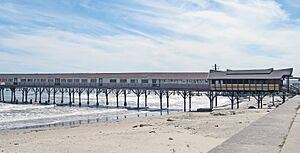
Clubs offering games of chance and drinks that were not allowed by law were the biggest tourist attractions on the island. While the Maceos ran the island's largest clubs, they generally allowed other clubs to operate. By the 1930s, Seawall Boulevard was full of fancy clubs. Other parts of town also had places for games. As late as 1950, about 300 businesses, from grocery stores to barber shops, had slot machines. Bars were even more common. In 1927, one report said there were 489 drinking places in the city, more than any other city on the Gulf Coast.
The financial success of these entertainment businesses attracted famous figures like Albert Anastasia from New York and Al Capone from Chicago. They tried to enter Galveston's market but didn't succeed.
Galveston became a major entry point for illegal alcohol from Mexico and Canada. It was shipped through the Caribbean Sea and then distributed from the island throughout Texas and to other places. Galveston became the main supplier for Houston, Dallas, and other cities. This traffic helped make up for the loss of shipping in cotton and sulfur.
The major legal businesses on the island, like banks and hotels, were able to do well largely because of the entertainment activities. While many of these business leaders didn't get directly involved with the Maceos' businesses, their relationships were friendly. Some, like businessman William Lewis Moody, Jr., even welcomed the games of chance because they brought tourists who filled his hotels. He was even known to lend money to the Maceos' group.
The Free State economy wasn't just on the island. It spread throughout Galveston County. In the county, large entertainment operations were run by the Fertitta, Salvato, and Maceo families. This included areas like Kemah and Dickinson. People from Houston often joked that the Galveston County line was the "Maceo-Dickinson line."
The entertainment activities on the island and in the county were not unique in Texas. But during the open era, Galveston's entertainment businesses were the most dominant. Other areas of the state sometimes had to crack down on these activities due to public pressure.
Galveston's Unique Culture
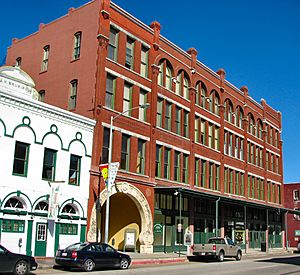
Society and Attitudes
The city's relaxed attitude wasn't just for the business leaders and politicians. The regular citizens also took pride in Galveston's traditional approach to freedom. A good example of this happened at a political rally. One candidate openly criticized the "hoodlums" running illegal activities. His opponent then spoke to the crowd as "my fellow hoodlums," which helped him win the election.
Even decades later, in 1993, when a Maceo family cousin fired at someone he believed owed him money, many in the community looked back at the incident with a sense of nostalgia for the Free State era.
While other parts of Texas sometimes allowed games of chance and illegal alcohol (Dallas reportedly had 27 clubs during World War II), these communities usually tried to hide it. In Galveston, attitudes were so relaxed that cards for betting on football were openly sold in high schools.
Galveston's high society regularly attracted some of the biggest names in entertainment. These included Frank Sinatra, Jayne Mansfield, Duke Ellington, and Bob Hope. Famous Houstonians like Howard Hughes also visited the clubs often.
Galveston's attitudes toward race were sometimes different from other parts of the region. The strict separation of races common in many parts of the U.S. was not always as strong in Galveston. One clear example was the gradual creation of mixed-race labor unions for waterfront workers starting in the 1800s. However, this alliance eventually faced challenges due to segregationist ideas.
Arts and Entertainment
The city had many places for the arts. This included the State Theater (now the Grand Opera House), which showed vaudeville acts and movies. Less formally, entertainment could be found at the Balinese Room, Hollywood Dinner Club, and other clubs. These places featured musical performances by major entertainers. For many years, the city also held free concerts on the beach with major orchestras and other performers.
The entertainment venues regularly attracted some of the biggest names in the entertainment business. These included Frank Sinatra, Sammy Davis Jr., Guy Lombardo, Jack Benny, Gene Autry, Phil Silvers, Jane Russell, George Burns, Duke Ellington, and Bob Hope.
Sports and Recreation
The Texas League, a baseball league, was founded in the 1800s. It stopped for a while and then restarted in the early 1900s, becoming a minor league. In the 1930s, investors in Galveston, especially Shearn Moody, created the Galveston Buccaneers baseball team. This team followed the earlier Galveston Pirates. The Buccaneers won the league championship in 1934. But the team was sold in 1937 after Moody passed away.
After World War II, the new Gulf Coast League was formed, and the Galveston White Caps team was created. Galveston won the championship in 1953. But the team then faded and was disbanded in 1955 as the rest of Galveston's economy was struggling.
The city started the Oleander Bowl football tournament in 1948. It later became the Shrimp Bowl and lasted until the late 1950s. It started as a tournament between colleges in the region. Eventually, it became a contest between local military units. The tournament was never very successful, only bringing in small crowds.
Government and Law Enforcement
After the 1900 hurricane, Galveston adopted a commission government. At the start of Prohibition, the city council first opposed games of chance and other entertainment activities that were outside the law. While they tolerated small-scale activities that had always been part of the city, they were more worried about organized groups.
As the Maceos organized these entertainment businesses and made them more accepted, the council became much more open to them. This was especially true as these businesses became very important to the local economy. Some reports say this was because the Maceos gained the cooperation of the council members.
Law enforcement at the county level, and to some extent at the state level, became famously tolerant of the entertainment activities in Galveston. This was partly because of the money they brought in, and the influence the Maceos had. The city police very quickly became completely involved.
Galveston County Sheriff Frank Biaggne served from 1933 to 1957. He was known for mostly ignoring the main entertainment activities on the island. When a state committee asked the sheriff why he didn't raid the Balinese Room, he simply said it was a "private club" and he was not a "member." The county attorney and local police commissioner were also very cooperative. According to a former Texas Ranger, a local judge would give search warrants to the Rangers for local clubs but would immediately call the owners to warn them.
This relaxed attitude from law enforcement generally did not harm the people. Besides the economic benefits from the Maceos, these leaders provided a high level of safety to the island's citizens. When serious crimes happened, the local police would sometimes contact the Maceos to have the matter handled. However, the island was not completely peaceful. Threats with a gun were a common way for the Maceo group to keep control. While the average citizen was relatively safe, killings of rivals did happen sometimes.
The End of an Era
The best years of the Free State were over by the 1940s. Due to issues with the U.S. Treasury, the Hollywood Dinner Club was shut down in the late 1930s. It became harder for local clubs to attract big entertainers.
Games of chance had been made legal in Nevada in 1931. This gave Nevada a big advantage over Galveston and other places where games were not allowed. This gradually drew figures like Bugsy Siegel to Las Vegas. The competition from the growing entertainment center in the desert greatly challenged Galveston over the next few years. Still, even in its later years, the Balinese Room was able to attract famous singers like Tony Bennett and Peggy Lee. As late as 1950, the Maceo family's businesses reportedly made $3.84 million a year.
By the late 1940s, corruption in Texas at the state and county levels was decreasing. Pressure against entertainment activities that were outside the law was growing across the state and nation. Even San Antonio's famous Sporting District was shut down in 1941. As state investigations into the Maceos' activities became more serious, Sam and Rose began planning to move their businesses to Nevada.
The Maceos became major investors in the Desert Inn, which was the largest and most elaborate casino resort on the Las Vegas Strip when it opened in 1950. Sam Maceo and Moe Dalitz (who opened the Desert Inn) had been friends and business partners for a long time. In fact, it was the Maceos' influence in the Nevada government that made Dalitz's operations possible. The Las Vegas project's funding was largely helped by the Maceos and Moodys through ANICO, which lent millions to known figures. Soon, ANICO was one of the biggest lenders to Las Vegas casinos.
Sam and Rose Maceo transferred control of most of their Galveston businesses to a new group led by the Fertitta family. Sam Maceo passed away in 1951, and Rose died in 1954.
The Free State Ends
During the 1950s, more dangerous groups took advantage of Galveston's relaxed law enforcement and the Maceo brothers' absence. Crime not related to entertainment increased in the city. The New Orleans crime group, led by Carlos Marcello, even moved guns to Cuba through the island.
By the 1950s, games of chance were being actively stopped in most parts of Texas. Paul Hopkins won the 1956 election for sheriff and decided to shut down the island's entertainment activities once and for all. One of the first successful arrests in the entertainment industry was an undercover operation by Texas Ranger Clint Peoples at the Balinese Room.
In 1957, Attorney General Will Wilson and Department of Public Safety head Homer Garrison began a huge campaign of raids. These raids destroyed the entertainment industry on the island, along with illegal alcohol imports. Forty-seven clubs and other entertainment places were reportedly closed, and 2,000 slot machines were destroyed. Although officials said they destroyed all the city's gaming equipment, some locals claimed that most of the equipment was shipped to Las Vegas before authorities ever found it.
Aftermath and New Beginnings
As the entertainment businesses crashed, so did tourism, and the rest of Galveston's economy declined. The economy struggled during the 1950s, and after 1957, the Free State was effectively gone. Fort Crockett, which had been an Army recreation center, closed in 1955. Many of the island's most important entertainment business leaders left the city and started new businesses in Las Vegas. Neither the economy nor the culture of the city was the same afterward.
City leaders tried several new projects, but they didn't always succeed. The city's television station moved to Houston in 1959. The telephone company headquarters and many other businesses also moved off the island. To make things worse, some of the island's attractions were destroyed by Hurricane Carla in 1961 and never rebuilt.
The economy continued in a quieter way. The three main powerful families on the island, the Moodys, the Sealys, and the Kempners, had almost complete control. The Splash Day celebrations restarted, bringing tourists back to the coast. Many hotels, banks, and some insurance companies remained, as did the medical and nursing schools and hospitals.
Efforts to preserve historical buildings, especially by George P. Mitchell, gradually helped to bring back the island's tourism industry. But it was very different from the past. In the 1980s, people voted on whether to make clubs with games of chance legal in the city, but voters said no each time. This showed how much the city had changed. However, recent polls suggest this feeling might be changing. In fact, games of chance on cruise ships leaving from Galveston are now common.
Galveston in Popular Culture
This era in Galveston's history hasn't received as much attention in popular culture as, for example, Al Capone's Chicago. However, some popular books and true crime stories have focused on this time.
Some notable examples include the novels Under the Skin by James Carlos Blake, Last Dance on the Starlight Pier by Sarah Bird, and Galveston by Suzanne Morris. The Balinese Room in Galveston was also the subject of a 1975 rock song by the band ZZ Top.
Galveston, The Musical! opened in 2003 in Galveston and in 2011 in Houston. This musical theater show tells the story of the Maceo brothers' arrival and the businesses they created during this special period in the island's history.
Images for kids


